Capstone Research Presentation: Calculator Use in Math Class
VerifiedAdded on 2021/04/16
|20
|1258
|103
Project
AI Summary
This capstone research presentation from the University of Texas at Arlington investigates the impact of calculators on middle school students' performance in mathematics. The study, conducted with a sample of students in Temple, Texas, employs a statistical approach to analyze the effects of calculator use on test scores, time taken to complete tests, word count in answers, and the frequency of calculation errors. The research compares data from tests where calculators were and were not permitted, using t-tests to evaluate hypotheses related to these factors. The findings suggest that calculators can significantly improve test scores, reduce the time needed to complete tests, and enable students to focus on conceptual understanding. The study concludes that calculators can be a beneficial tool in mathematics education, especially when used appropriately based on the difficulty level of the problems.
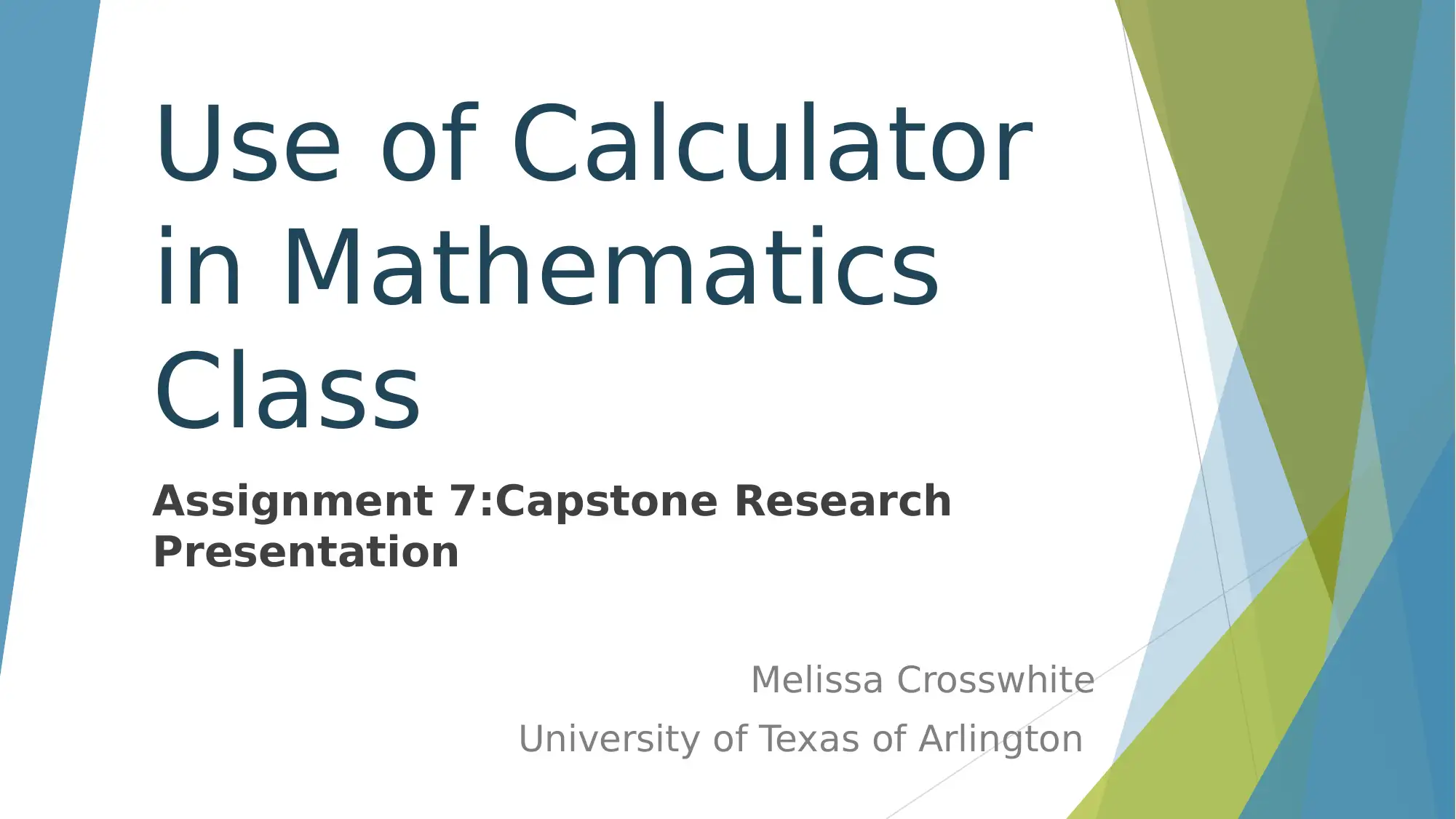
Use of Calculator
in Mathematics
Class
Assignment 7:Capstone Research
Presentation
Melissa Crosswhite
University of Texas of Arlington
in Mathematics
Class
Assignment 7:Capstone Research
Presentation
Melissa Crosswhite
University of Texas of Arlington
Paraphrase This Document
Need a fresh take? Get an instant paraphrase of this document with our AI Paraphraser
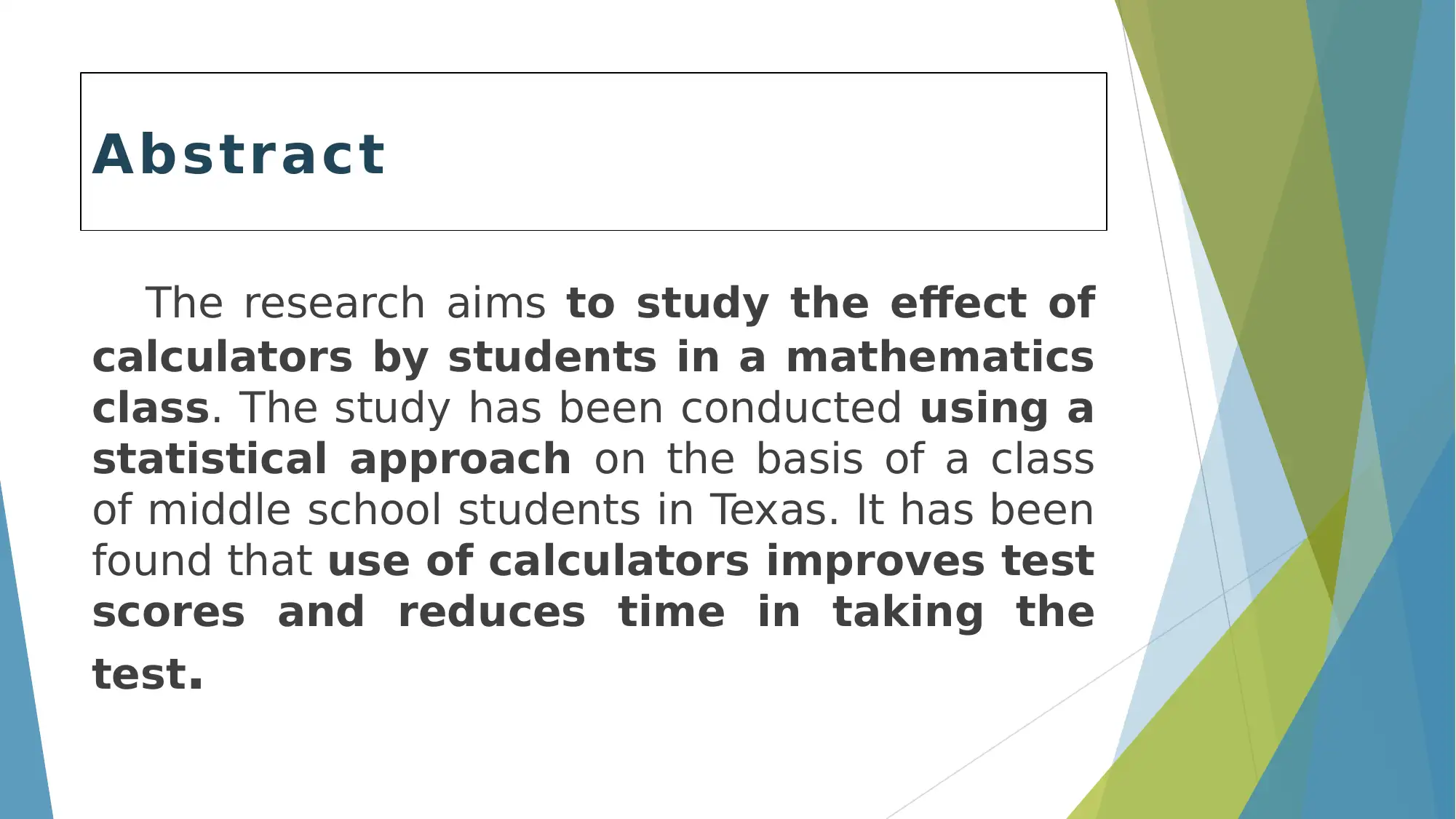
Abstract
The research aims to study the effect of
calculators by students in a mathematics
class. The study has been conducted using a
statistical approach on the basis of a class
of middle school students in Texas. It has been
found that use of calculators improves test
scores and reduces time in taking the
test.
The research aims to study the effect of
calculators by students in a mathematics
class. The study has been conducted using a
statistical approach on the basis of a class
of middle school students in Texas. It has been
found that use of calculators improves test
scores and reduces time in taking the
test.
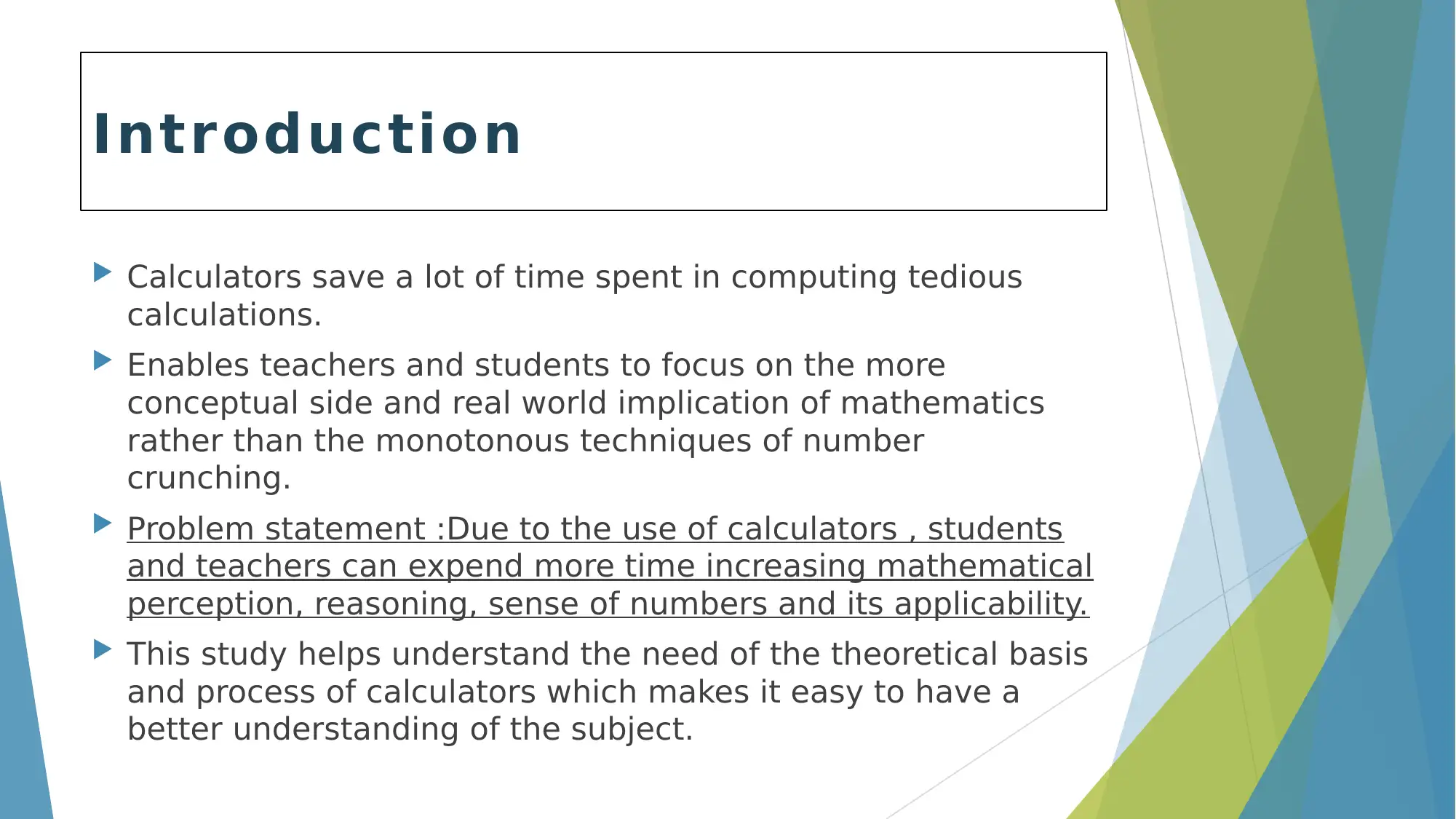
Introduction
Calculators save a lot of time spent in computing tedious
calculations.
Enables teachers and students to focus on the more
conceptual side and real world implication of mathematics
rather than the monotonous techniques of number
crunching.
Problem statement :Due to the use of calculators , students
and teachers can expend more time increasing mathematical
perception, reasoning, sense of numbers and its applicability.
This study helps understand the need of the theoretical basis
and process of calculators which makes it easy to have a
better understanding of the subject.
Calculators save a lot of time spent in computing tedious
calculations.
Enables teachers and students to focus on the more
conceptual side and real world implication of mathematics
rather than the monotonous techniques of number
crunching.
Problem statement :Due to the use of calculators , students
and teachers can expend more time increasing mathematical
perception, reasoning, sense of numbers and its applicability.
This study helps understand the need of the theoretical basis
and process of calculators which makes it easy to have a
better understanding of the subject.
⊘ This is a preview!⊘
Do you want full access?
Subscribe today to unlock all pages.

Trusted by 1+ million students worldwide
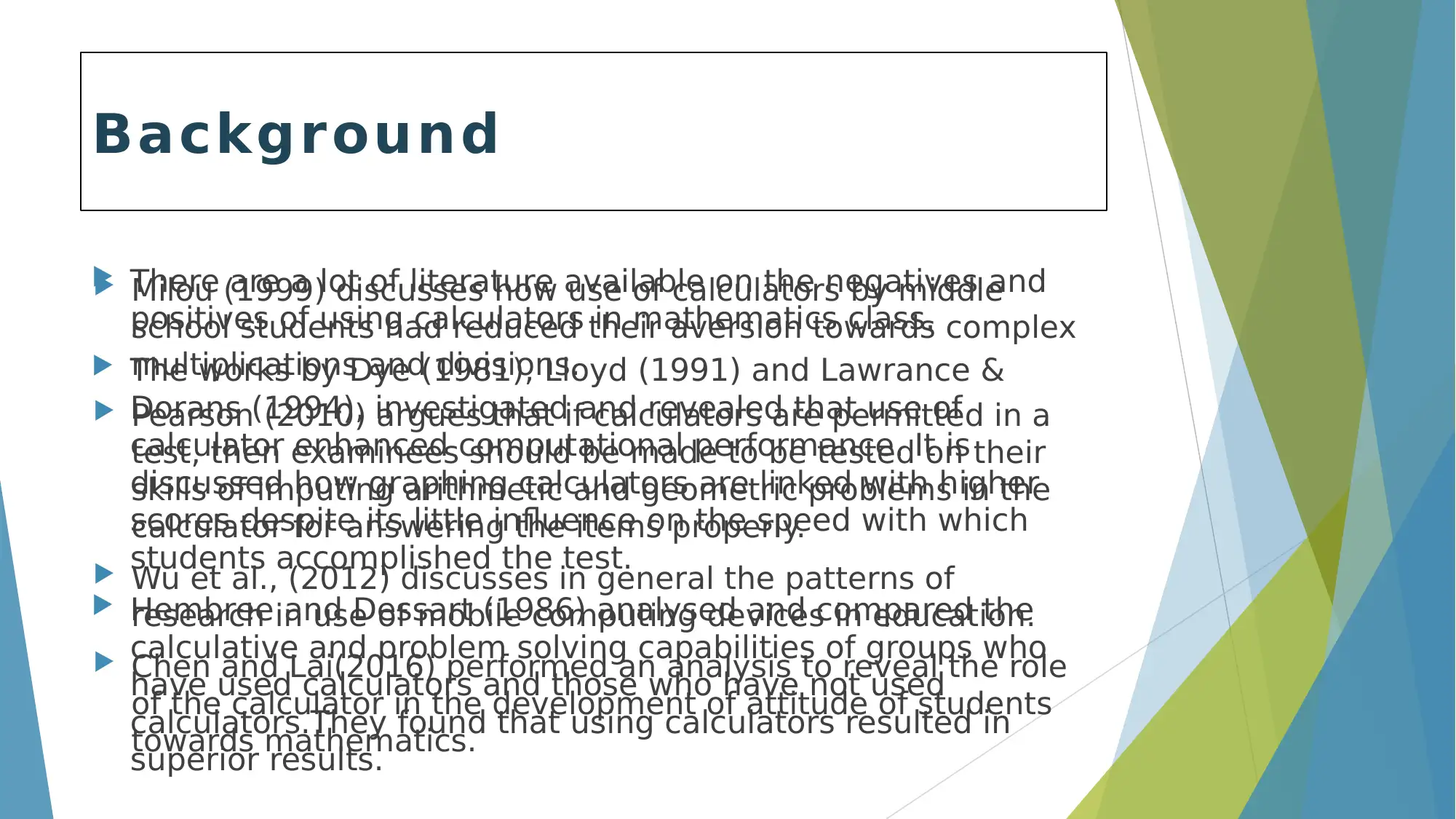
Background
There are a lot of literature available on the negatives and
positives of using calculators in mathematics class.
The works by Dye (1981), Lloyd (1991) and Lawrance &
Dorans (1994), investigated and revealed that use of
calculator enhanced computational performance. It is
discussed how graphing calculators are linked with higher
scores despite its little influence on the speed with which
students accomplished the test.
Hembree and Dessart (1986) analysed and compared the
calculative and problem solving capabilities of groups who
have used calculators and those who have not used
calculators.They found that using calculators resulted in
superior results.
Milou (1999) discusses how use of calculators by middle
school students had reduced their aversion towards complex
multiplications and divisions.
Pearson (2010) argues that if calculators are permitted in a
test, then examinees should be made to be tested on their
skills of imputing arithmetic and geometric problems in the
calculator for answering the items properly.
Wu et al., (2012) discusses in general the patterns of
research in use of mobile computing devices in education.
Chen and Lai(2016) performed an analysis to reveal the role
of the calculator in the development of attitude of students
towards mathematics.
There are a lot of literature available on the negatives and
positives of using calculators in mathematics class.
The works by Dye (1981), Lloyd (1991) and Lawrance &
Dorans (1994), investigated and revealed that use of
calculator enhanced computational performance. It is
discussed how graphing calculators are linked with higher
scores despite its little influence on the speed with which
students accomplished the test.
Hembree and Dessart (1986) analysed and compared the
calculative and problem solving capabilities of groups who
have used calculators and those who have not used
calculators.They found that using calculators resulted in
superior results.
Milou (1999) discusses how use of calculators by middle
school students had reduced their aversion towards complex
multiplications and divisions.
Pearson (2010) argues that if calculators are permitted in a
test, then examinees should be made to be tested on their
skills of imputing arithmetic and geometric problems in the
calculator for answering the items properly.
Wu et al., (2012) discusses in general the patterns of
research in use of mobile computing devices in education.
Chen and Lai(2016) performed an analysis to reveal the role
of the calculator in the development of attitude of students
towards mathematics.
Paraphrase This Document
Need a fresh take? Get an instant paraphrase of this document with our AI Paraphraser

M e t h o d o l o g y

Data Collection: Procedure
Sample of 50 students out of 521 students from 6th to 8th
grade of a school in Temple, Texas has been randomly
selected.
There are 48% Hispanic, 32% White, 17%Black, 2% Mixed
Races and 1% Asians among the students (Public School
Review, 2003-2016).
Among these, 25 students were selected from each
“Regular math class” and “AP math class” each.
Two tests were conducted over two consecutive weeks on
the selected subjects.
A complete enumeration of the performance records of the
subjects in the tests was carried out.
Sample of 50 students out of 521 students from 6th to 8th
grade of a school in Temple, Texas has been randomly
selected.
There are 48% Hispanic, 32% White, 17%Black, 2% Mixed
Races and 1% Asians among the students (Public School
Review, 2003-2016).
Among these, 25 students were selected from each
“Regular math class” and “AP math class” each.
Two tests were conducted over two consecutive weeks on
the selected subjects.
A complete enumeration of the performance records of the
subjects in the tests was carried out.
⊘ This is a preview!⊘
Do you want full access?
Subscribe today to unlock all pages.

Trusted by 1+ million students worldwide
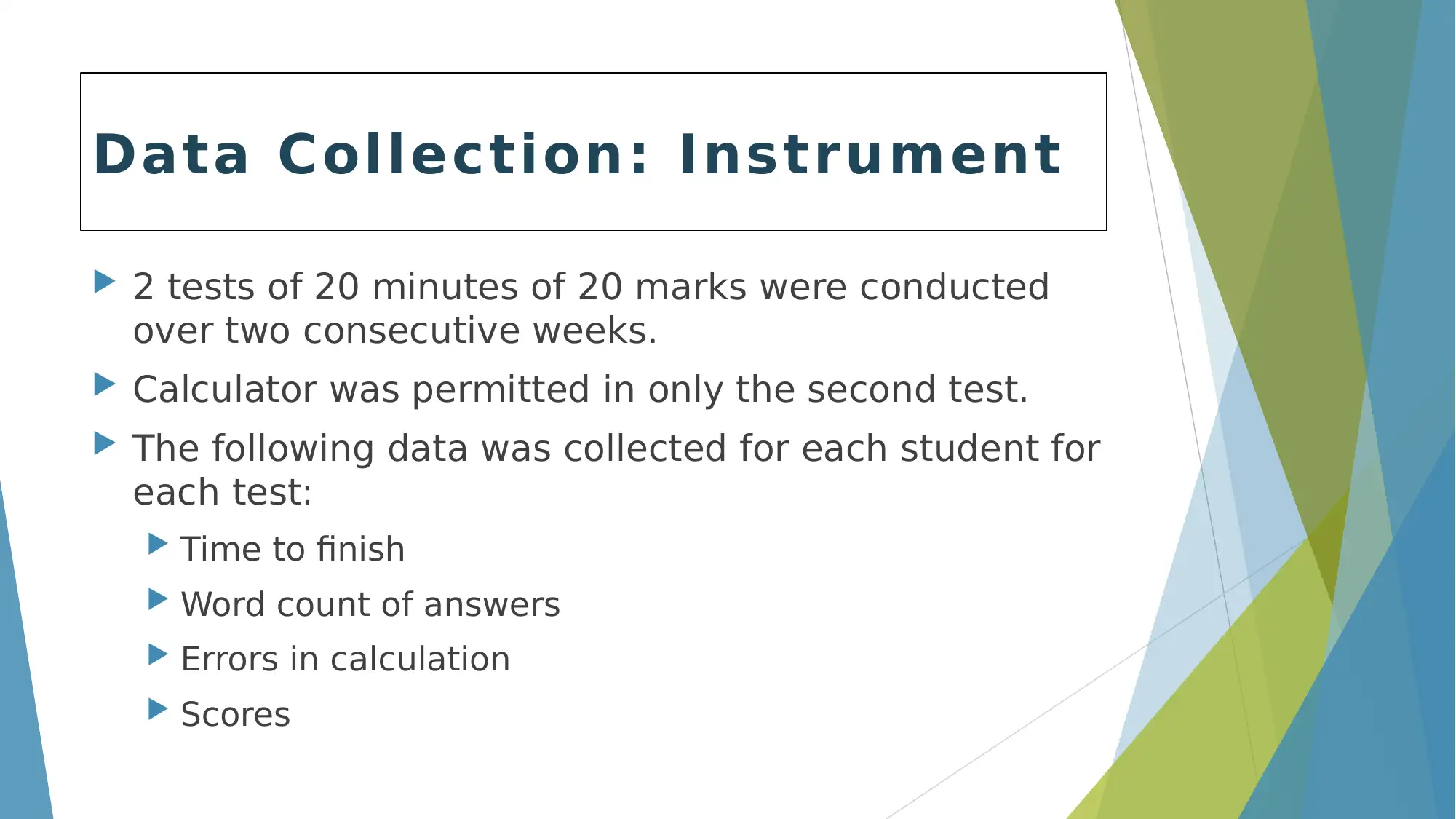
Data Collection: Instrument
2 tests of 20 minutes of 20 marks were conducted
over two consecutive weeks.
Calculator was permitted in only the second test.
The following data was collected for each student for
each test:
Time to finish
Word count of answers
Errors in calculation
Scores
2 tests of 20 minutes of 20 marks were conducted
over two consecutive weeks.
Calculator was permitted in only the second test.
The following data was collected for each student for
each test:
Time to finish
Word count of answers
Errors in calculation
Scores
Paraphrase This Document
Need a fresh take? Get an instant paraphrase of this document with our AI Paraphraser
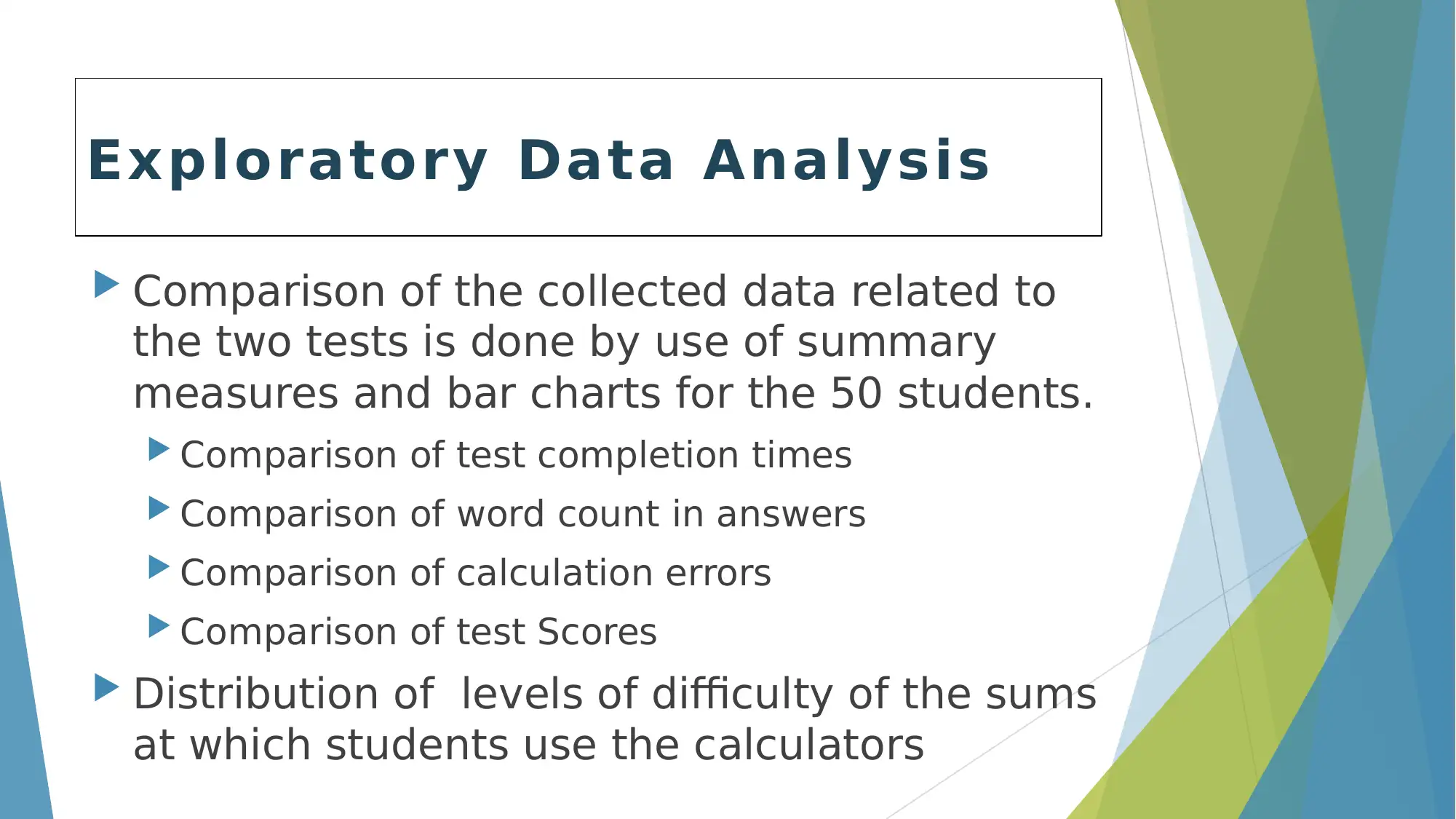
Comparison of the collected data related to
the two tests is done by use of summary
measures and bar charts for the 50 students.
Comparison of test completion times
Comparison of word count in answers
Comparison of calculation errors
Comparison of test Scores
Distribution of levels of difficulty of the sums
at which students use the calculators
Exploratory Data Analysis
the two tests is done by use of summary
measures and bar charts for the 50 students.
Comparison of test completion times
Comparison of word count in answers
Comparison of calculation errors
Comparison of test Scores
Distribution of levels of difficulty of the sums
at which students use the calculators
Exploratory Data Analysis
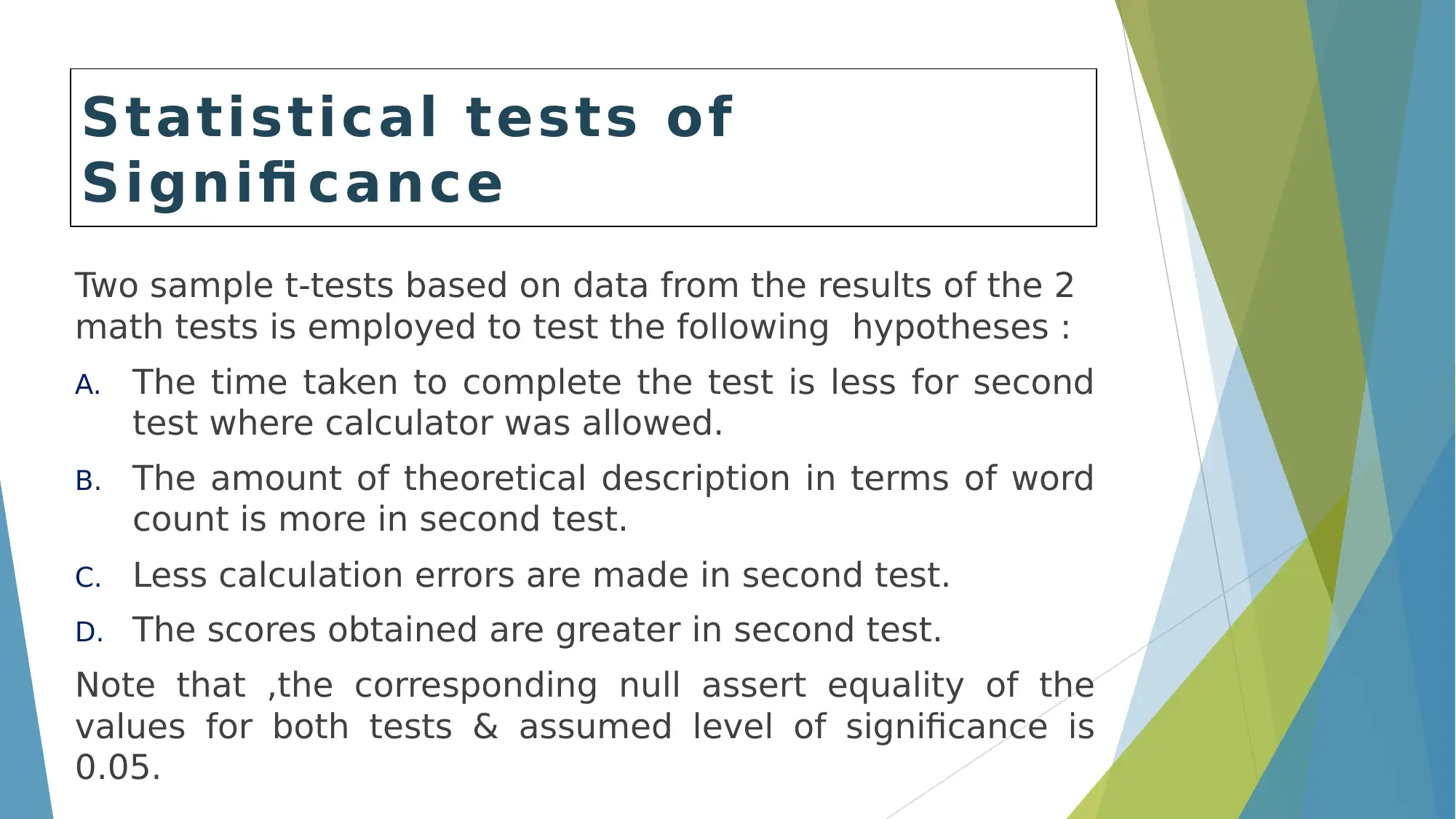
Two sample t-tests based on data from the results of the 2
math tests is employed to test the following hypotheses :
A. The time taken to complete the test is less for second
test where calculator was allowed.
B. The amount of theoretical description in terms of word
count is more in second test.
C. Less calculation errors are made in second test.
D. The scores obtained are greater in second test.
Note that ,the corresponding null assert equality of the
values for both tests & assumed level of significance is
0.05.
Statistical tests of
Signifi cance
math tests is employed to test the following hypotheses :
A. The time taken to complete the test is less for second
test where calculator was allowed.
B. The amount of theoretical description in terms of word
count is more in second test.
C. Less calculation errors are made in second test.
D. The scores obtained are greater in second test.
Note that ,the corresponding null assert equality of the
values for both tests & assumed level of significance is
0.05.
Statistical tests of
Signifi cance
⊘ This is a preview!⊘
Do you want full access?
Subscribe today to unlock all pages.

Trusted by 1+ million students worldwide

R e s u l t s
Paraphrase This Document
Need a fresh take? Get an instant paraphrase of this document with our AI Paraphraser
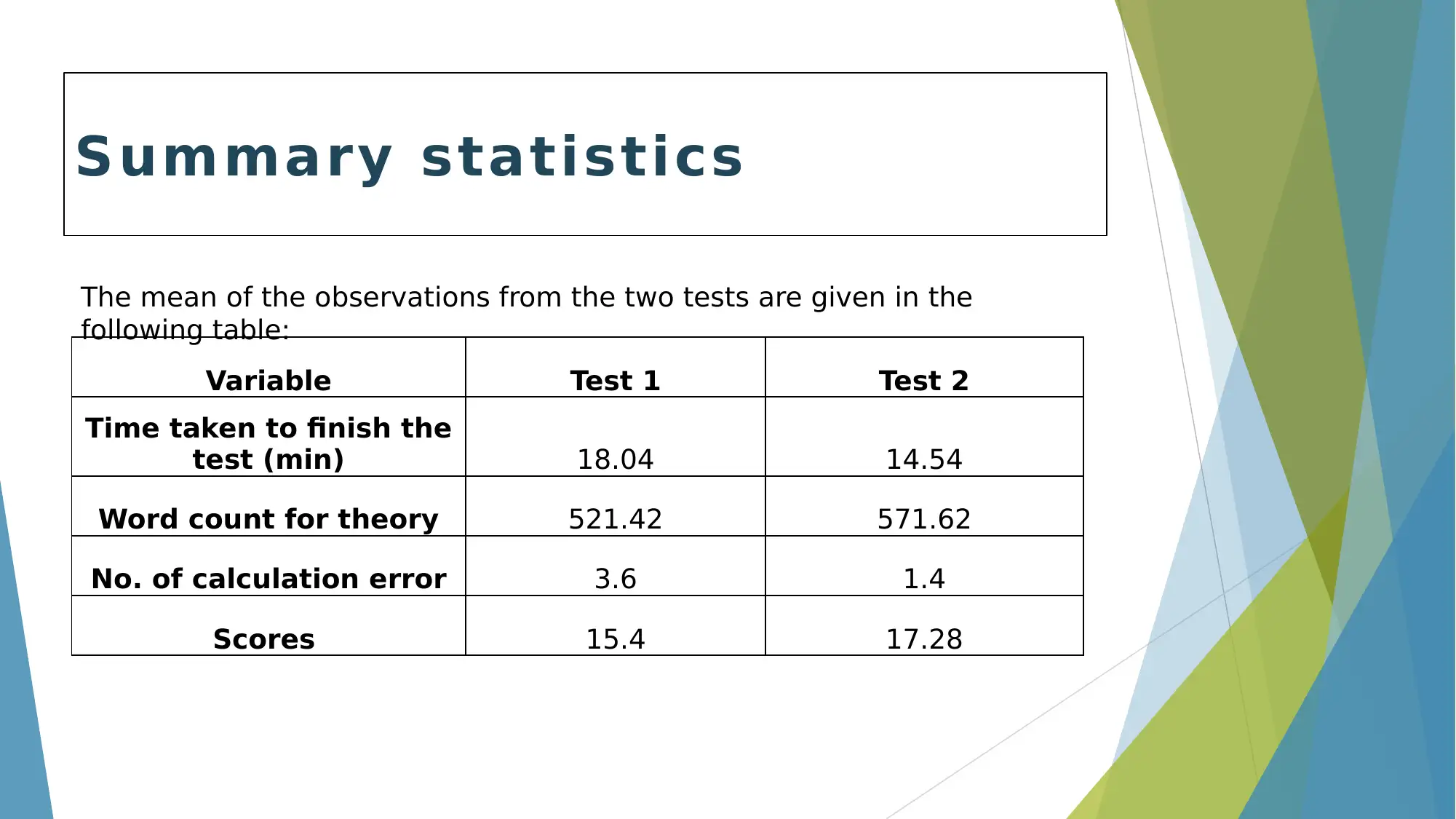
Summary statistics
Variable Test 1 Test 2
Time taken to finish the
test (min) 18.04 14.54
Word count for theory 521.42 571.62
No. of calculation error 3.6 1.4
Scores 15.4 17.28
The mean of the observations from the two tests are given in the
following table:
Variable Test 1 Test 2
Time taken to finish the
test (min) 18.04 14.54
Word count for theory 521.42 571.62
No. of calculation error 3.6 1.4
Scores 15.4 17.28
The mean of the observations from the two tests are given in the
following table:
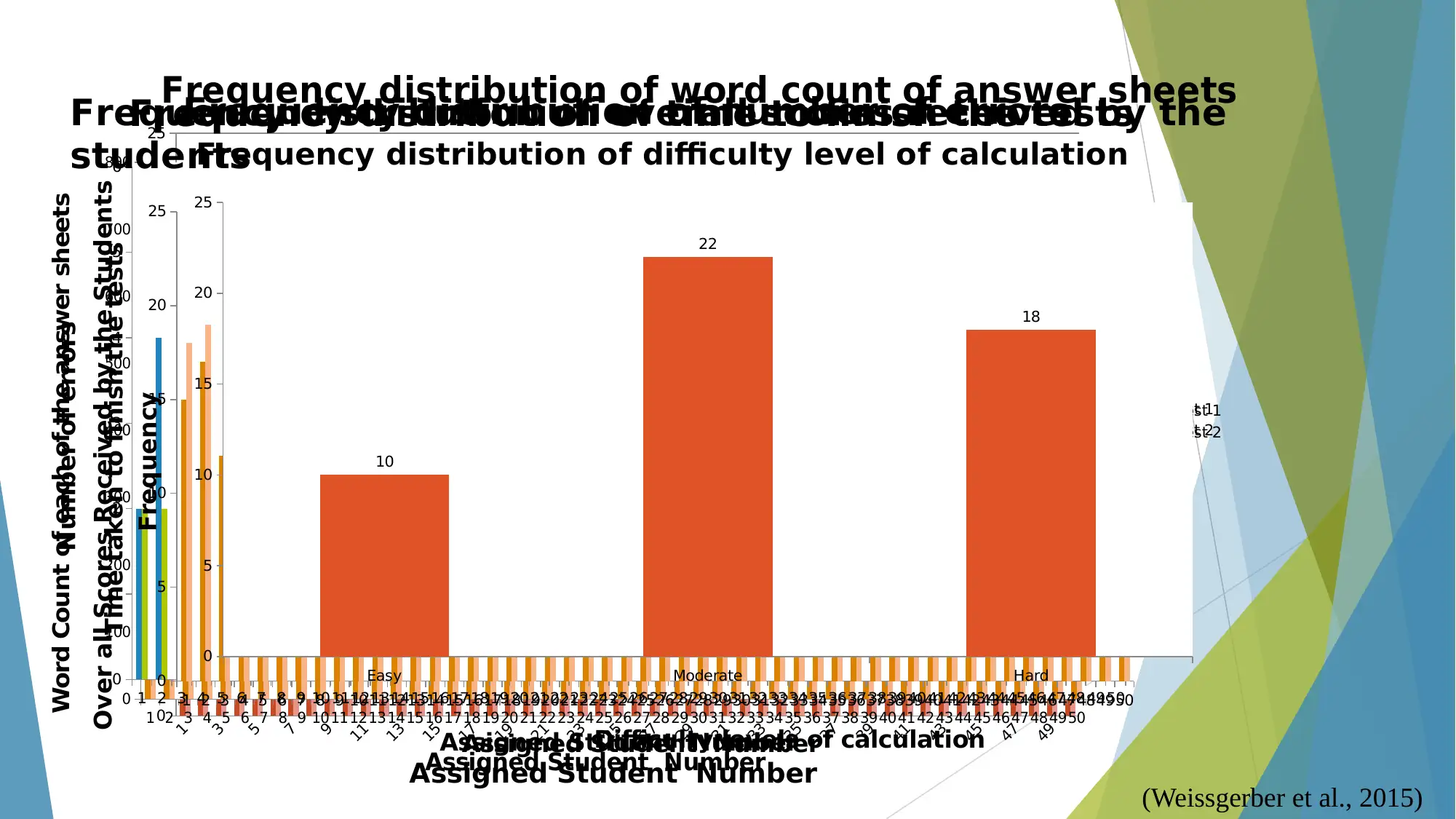
1
3
5
7
9
11
13
15
17
19
21
23
25
27
29
31
33
35
37
39
41
43
45
47
49
0
5
10
15
20
25
Frequency distribution of time to finish the tests
Test 1
Test 2
Assigned Student Number
Time taken to finish the tests
1 2 3 4 5 6 7 8 9 1011121314151617181920212223242526272829303132333435363738394041424344454647484950
0
100
200
300
400
500
600
700
800
Frequency distribution of word count of answer sheets
Test 1
Test 2
Assigned Student Number
Word Count of each of the answer sheets
1 2 3 4 5 6 7 8 9 1011121314151617181920212223242526272829303132333435363738394041424344454647484950
0
1
2
3
4
5
6
Frequency distribution of number of errors
Test 1
Test 2
Assigned Student Number
Number of errors
1 2 3 4 5 6 7 8 9 1011121314151617181920212223242526272829303132333435363738394041424344454647484950
0
5
10
15
20
25
Frequency distribution of overall scores received by the
students
Test 1
Test 2
Assigned Student Number
Over all Scores Received by the Students
(Weissgerber et al., 2015)
Easy Moderate Hard
0
5
10
15
20
25
10
22
18
Frequency distribution of difficulty level of calculation
Difficulty levels of calculation
Frequency
3
5
7
9
11
13
15
17
19
21
23
25
27
29
31
33
35
37
39
41
43
45
47
49
0
5
10
15
20
25
Frequency distribution of time to finish the tests
Test 1
Test 2
Assigned Student Number
Time taken to finish the tests
1 2 3 4 5 6 7 8 9 1011121314151617181920212223242526272829303132333435363738394041424344454647484950
0
100
200
300
400
500
600
700
800
Frequency distribution of word count of answer sheets
Test 1
Test 2
Assigned Student Number
Word Count of each of the answer sheets
1 2 3 4 5 6 7 8 9 1011121314151617181920212223242526272829303132333435363738394041424344454647484950
0
1
2
3
4
5
6
Frequency distribution of number of errors
Test 1
Test 2
Assigned Student Number
Number of errors
1 2 3 4 5 6 7 8 9 1011121314151617181920212223242526272829303132333435363738394041424344454647484950
0
5
10
15
20
25
Frequency distribution of overall scores received by the
students
Test 1
Test 2
Assigned Student Number
Over all Scores Received by the Students
(Weissgerber et al., 2015)
Easy Moderate Hard
0
5
10
15
20
25
10
22
18
Frequency distribution of difficulty level of calculation
Difficulty levels of calculation
Frequency
⊘ This is a preview!⊘
Do you want full access?
Subscribe today to unlock all pages.

Trusted by 1+ million students worldwide
1 out of 20
Related Documents
Your All-in-One AI-Powered Toolkit for Academic Success.
+13062052269
info@desklib.com
Available 24*7 on WhatsApp / Email
![[object Object]](/_next/static/media/star-bottom.7253800d.svg)
Unlock your academic potential
Copyright © 2020–2025 A2Z Services. All Rights Reserved. Developed and managed by ZUCOL.





